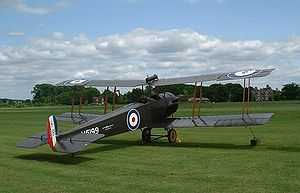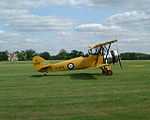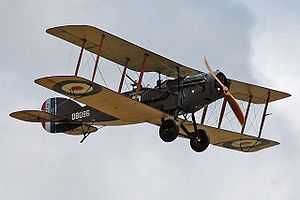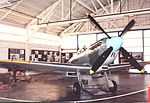Reach for the Sky
| Reach for the Sky | |
|---|---|
 original theatrical poster | |
| Directed by | Lewis Gilbert |
| Produced by | Daniel M. Angel |
| Written by |
Paul Brickhill (book) Lewis Gilbert (screenplay) Vernon Harris (add'l scenes) |
| Starring |
Kenneth More Muriel Pavlow Lyndon Brook Lee Patterson Alexander Knox |
| Music by | John Addison |
| Cinematography | Jack Asher |
| Edited by | John Shirley |
| Distributed by | The Rank Organisation |
Release dates |
(US) |
Running time | 136 minutes |
| Country | United Kingdom |
| Language | English |
Reach for the Sky is a 1956 British biographical film about aviator Douglas Bader, based on the 1954 biography of the same name by Paul Brickhill. The film stars Kenneth More and was directed by Lewis Gilbert. It won the BAFTA Award for Best British Film of 1956.
Plot
In 1928, Douglas Bader joins the Royal Air Force (RAF) as a cadet. Despite a friendly reprimand from Air Vice-Marshal Halahan for his disregard for service discipline and flight rules, he successfully completes his training and is posted to No. 23 Squadron at RAF Kenley. In 1930, he is chosen to be among the pilots for an aerial exhibition.
Later, although his flight commander has explicitly banned low level aerobatics (as two pilots have been killed trying just that), he is goaded into it by a disparaging remark by a civilian pilot. He crashes.
Mr Joyce, surgeon at the Royal Berkshire Hospital, has to amputate both legs to save Bader's life. During his convalescence, he receives encouragement from Nurse Brace. Upon his discharge from the hospital, he sets out to master prosthetic legs. At a stop for some tea, he meets waitress Thelma Edwards. Once he can walk on his own, he starts courting her.
Despite his undiminished skills, he is refused flying duties simply because there are no regulations covering his situation. Offered a desk job instead, he leaves the RAF and works unhappily in an office. He and Thelma marry.
As the Second World War starts, Bader talks himself back into the RAF. He is soon given command of a squadron comprising mostly dispirited Canadians who had fought in France. Improving morale and brazenly circumventing normal channels to obtain badly needed equipment, he makes the squadron operational again. They fight effectively in the Battle of Britain. Bader is then put in charge of a new, larger formation of five squadrons. Later, he is posted to RAF Tangmere and promoted to wing commander.
In 1941, Bader has to bail out over France. He is caught, escapes, and is recaptured. He then makes such a nuisance of himself to his jailers, he is repeatedly moved from one POW camp to another, finally ending up in Colditz Castle. He is liberated after four years of captivity. The war ends (much to Thelma's relief) before Bader can have "one last fling" in the Far East.
On 15 September 1945, the fifth anniversary of the greatest day of the Battle of Britain, Bader, now a group captain, is given the honour of leading eleven other battle survivors and a total of 300 aircraft in a flypast over London.
Cast
Credited
|
|
Uncredited
|
|
Aircraft
The following aircraft were used in the filming of Reach for the Sky.[1]
| Aircraft | Registration or serial |
Role | Fate | Photo |
|---|---|---|---|---|
| Avro 504K | E3404 | Flying | Preserved at Shuttleworth Collection, Old Warden, United Kingdom.[Note 1] |  |
| Avro Tutor | K3215 | Static | Preserved at Shuttleworth Collection. |  |
| Bristol F.2b | D8096 | Camera ship | Preserved at Shuttleworth Collection. |  |
| Bristol Bulldog | K2227 | Static | Preserved at RAF Museum, Hendon, United Kingdom. |  |
| Hawker Hurricane I | P2617 | Static | static exhibit at RAF hendon Museum. | |
| Hawker Hurricane IIC | LF363 | Flying | Airworthy with the Battle of Britain Memorial Flight, RAF Coningsby, United Kingdom. |  |
| Hawker Hurricane IIC | unknown | Static | Believed scrapped. | |
| Spartan Arrow | G-ABWP | Static | Airworthy, privately owned. | .jpg) |
| Supermarine Spitfire XVI | RW345 | Static | Scrapped May 1956 | |
| Supermarine Spitfire XVI | RW352 | Flying | Scrapped 1957 | |
| Supermarine Spitfire XVI | SL574 | Flying | Preserved at the Air & Space Museum, San Diego, United States. |  |
| Supermarine Spitfire XVI | SL745 | Static | Scrapped May 1956 | |
| Supermarine Spitfire XVI | TB293 | Static | Scrapped May 1956 | |
| Supermarine Spitfire XVI | TB885 | Static | Under restoration in United Kingdom to flying condition. | |
| Supermarine Spitfire XVI | TE288 | Static | Preserved at Royal New Zealand Air Force Museum, Wigram, New Zealand |  |
| Supermarine Spitfire XVI | TE341 | Static | Scrapped at Pinewood Studios | |
| Supermarine Spitfire XVI | TE358 | Flying | Scrapped by Coley's Ltd, Feltham, United Kingdom in April 1957 | |
| Supermarine Spitfire XVI | TE456 | Flying | Preserved at Auckland War Memorial Museum, Auckland, New Zealand |  |
Production
To depict the various Royal Air Force bases realistically, principal filming took place in Surrey at RAF Kenley, and around the village of Bagshot. Studio work was completed at the Pinewood Studios, Iver Heath, Buckinghamshire, England, UK. Available wartime combat aircraft including Hawker Hurricane and Supermarine Spitfire fighters were arranged to take on the aerial scenes.
According to Ben Mankiewicz on TCM, Richard Burton was producer Danny Angel's first choice for the lead but he dropped out. More's fee was £25,000.[2] Mankiewicz also noted that More arranged to meet Bader to prepare for the role. They played a round of golf; much to More's surprise (as he was a good golfer), Bader beat him decisively.[3]
Reception
The film fared well with the public, being the most popular film in the UK for 1956. When the film was released in North America in 1957, the American release version was slightly altered with 12 minutes edited out. Rank made a concerted effort to ensure the film was successful in America, sending Kenneth More over to do a press tour, but the public was not enthusiastic.[4]
References
Notes
- ↑ All dates are as of August 2010 unless indicated otherwise.
Citations
- ↑ "Lewis Gilbert, Douglas Bader's film biographer." Aeroplane, Vol. 38, No. 9, September 2010, p. 28.
- ↑ More 1978, p. 169.
- ↑ "Exploits of air ace Bader in war epic." The Australian Women's Weekly (1933–1982) via National Library of Australia, 26 October 1955, p. 31. Retrieved: 6 May 2012.
- ↑ More 1978, p. 181.
Bibliography
- Bader, Douglas. Fight for the Sky: The Story of the Spitfire and Hurricane. Ipswich, Suffolk, UK: W.S. Cowell Ltd., 2004. ISBN 0-304-35674-3.
- Brickhill, Paul. Reach for the Sky: The Story of Douglas Bader DSO, DFC. London: Odhams Press Ltd., 1954. ISBN 1-55750-222-6.
- Dolan, Edward F. Jr. Hollywood Goes to War. London: Bison Books, 1985. ISBN 0-86124-229-7.
- Hardwick, Jack and Ed Schnepf. "A Buff's Guide to Aviation Movies". Air Progress Aviation Vol. 7, No. 1, Spring 1983.
- More, Kenneth. More or Less. London: Hodder & Staughton, 1978. ISBN 978-0-340-22603-2.
External links
| ||||||